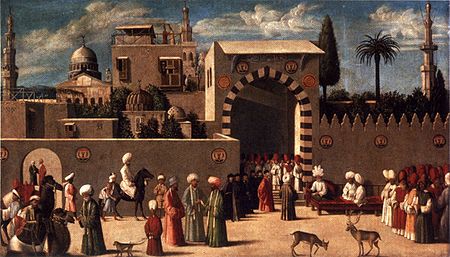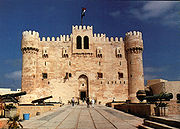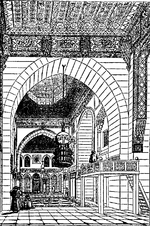
Qaitbay
Encyclopedia

Burji dynasty
The Burji dynasty المماليك البرجية ruled Egypt from 1382 until 1517. It proved especially turbulent, with short-lived sultans. Political power-plays often became important in designating a new sultan. During this time Mamluks fought Timur Lenk and conquered Cyprus. Constant bickering may have...
Mamluk
Mamluk
A Mamluk was a soldier of slave origin, who were predominantly Cumans/Kipchaks The "mamluk phenomenon", as David Ayalon dubbed the creation of the specific warrior...
Sultan of Egypt
Egypt
Egypt , officially the Arab Republic of Egypt, Arabic: , is a country mainly in North Africa, with the Sinai Peninsula forming a land bridge in Southwest Asia. Egypt is thus a transcontinental country, and a major power in Africa, the Mediterranean Basin, the Middle East and the Muslim world...
from 872-901 A.H.
Islamic calendar
The Hijri calendar , also known as the Muslim calendar or Islamic calendar , is a lunar calendar consisting of 12 lunar months in a year of 354 or 355 days. It is used to date events in many Muslim countries , and used by Muslims everywhere to determine the proper day on which to celebrate Islamic...
(AD 1468-1496). (Other transliterations of his name include Qaytbay and Kait Bey.) He was Circassian by birth, and was purchased by the ninth sultan Barsbay
Barsbay
Al-Ashraf Sayf-ad-Din Barsbay was the ninth Burji Mamluk sultan of Egypt from AD 1422 to 1438. He was Circassian by birth and a former slave of the first Burji Sultan, Barquq....
(AD 1422 to 1438) before being freed by the eleventh sultan Jaqmaq (AD 1438 to 1453). During his reign he stabilized the Mamluk state and economy, consolidated the northern boundaries of the Sultanate with the Ottoman Empire
Ottoman Empire
The Ottoman EmpireIt was usually referred to as the "Ottoman Empire", the "Turkish Empire", the "Ottoman Caliphate" or more commonly "Turkey" by its contemporaries...
, and emerged as a great patron of art and architecture. In fact, although Qaitbay fought sixteen military campaigns, he is best remembered for the spectacular building projects that he sponsored, leaving his mark as an architectural patron on Mecca
Mecca
Mecca is a city in the Hijaz and the capital of Makkah province in Saudi Arabia. The city is located inland from Jeddah in a narrow valley at a height of above sea level...
, Medina
Medina
Medina , or ; also transliterated as Madinah, or madinat al-nabi "the city of the prophet") is a city in the Hejaz region of western Saudi Arabia, and serves as the capital of the Al Madinah Province. It is the second holiest city in Islam, and the burial place of the Islamic Prophet Muhammad, and...
, Jerusalem, Damascus
Damascus
Damascus , commonly known in Syria as Al Sham , and as the City of Jasmine , is the capital and the second largest city of Syria after Aleppo, both are part of the country's 14 governorates. In addition to being one of the oldest continuously inhabited cities in the world, Damascus is a major...
, Aleppo
Aleppo
Aleppo is the largest city in Syria and the capital of Aleppo Governorate, the most populous Syrian governorate. With an official population of 2,301,570 , expanding to over 2.5 million in the metropolitan area, it is also one of the largest cities in the Levant...
, Alexandria
Alexandria
Alexandria is the second-largest city of Egypt, with a population of 4.1 million, extending about along the coast of the Mediterranean Sea in the north central part of the country; it is also the largest city lying directly on the Mediterranean coast. It is Egypt's largest seaport, serving...
, and every quarter of Cairo
Cairo
Cairo , is the capital of Egypt and the largest city in the Arab world and Africa, and the 16th largest metropolitan area in the world. Nicknamed "The City of a Thousand Minarets" for its preponderance of Islamic architecture, Cairo has long been a centre of the region's political and cultural life...
.
Early life
Qaitbay was born in the Circassian region of the Caucasus between 1416 and 1418. His skill in archery and horsemanship attracted the attention of a slave merchant who purchased him and brought him to Cairo when he was already over twenty years of age. He was quickly purchased by the reigning sultan Barsbay and became a member of the palace guard. He was freed by Barsbay's successor, Jaqmaq, and appointed third executive secretary; under the reigns of Inal, Khushqadam, and Yilbay he was further promoted through the Mamluk military hierarchy, eventually becoming taqaddimat alf, commander of a thousand Mamluks. Under the Sultan Timurbugha, finally, Qaitbay was appointed atabak, or field marshal of the entire Mamluk army. During this period Qaitbay amassed a considerable personal fortune which would enable him to exercise substantial acts of beneficence as sultan without draining the royal treasury.Accession

Early reign
Qaitbay's first major challenge was the insurrection of Shah Suwar, leader of a small Turkmen dynasty, the Dhu'l-Qadrids, in eastern Anatolia. A first expedition against the upstart was soundly defeated, and Suwar threatened to invade Syria. A second Mamluk army was sent in 1469 under the leadership of Azbak, but was likewise defeated. Not until 1471 did a third expedition, this time commanded by Yashbak, succeed in routing Suwar's army. In 1473 Suwar was captured and led back to Cairo, together with his brothers; the prisoners were drawn and quartered and their remains were hung from Bab ZuwaylaBab Zuweila
Bab Zuweila is a medieval gate in Cairo, which is still standing in modern times. It was also known as Bawabbat al-Mitwali during the Ottoman period, and is sometimes spelled Bab Zuwayla. It is considered one of the major landmarks of the city, and is the last remaining southern gate from the...
.
Consolidation of power
Following the defeat of Suwar, Qaitbay set about purging his court of the remaining factions and installing his own purchased Mamluks in all positions of power. He frequently went on excursions, ostentatiously leaving the CitadelCairo Citadel
The Saladin Citadel of Cairo is a medieval Islamic fortification in Cairo, Egypt. The location, on Mokattam hill near the center of Cairo, was once famous for its fresh breeze and grand views of the city...
with limited guards to display his trust of his subordinates and of the populace. He traveled throughout his reign, visiting Alexandria
Alexandria
Alexandria is the second-largest city of Egypt, with a population of 4.1 million, extending about along the coast of the Mediterranean Sea in the north central part of the country; it is also the largest city lying directly on the Mediterranean coast. It is Egypt's largest seaport, serving...
, Damascus
Damascus
Damascus , commonly known in Syria as Al Sham , and as the City of Jasmine , is the capital and the second largest city of Syria after Aleppo, both are part of the country's 14 governorates. In addition to being one of the oldest continuously inhabited cities in the world, Damascus is a major...
, and Aleppo
Aleppo
Aleppo is the largest city in Syria and the capital of Aleppo Governorate, the most populous Syrian governorate. With an official population of 2,301,570 , expanding to over 2.5 million in the metropolitan area, it is also one of the largest cities in the Levant...
, among other cities, and personally inspecting his many building projects. In 1472 he performed the Hajj
Hajj
The Hajj is the pilgrimage to Mecca, Saudi Arabia. It is one of the largest pilgrimages in the world, and is the fifth pillar of Islam, a religious duty that must be carried out at least once in their lifetime by every able-bodied Muslim who can afford to do so...
to Mecca
Mecca
Mecca is a city in the Hijaz and the capital of Makkah province in Saudi Arabia. The city is located inland from Jeddah in a narrow valley at a height of above sea level...
. He was struck by the poverty of the citizens of Medina
Medina
Medina , or ; also transliterated as Madinah, or madinat al-nabi "the city of the prophet") is a city in the Hejaz region of western Saudi Arabia, and serves as the capital of the Al Madinah Province. It is the second holiest city in Islam, and the burial place of the Islamic Prophet Muhammad, and...
and devoted a substantial portion of his private fortune to the alleviation of their plight. Through such measures Qaitbay gained a reputation for piety, charity, and royal self-confidence.
Ottoman-Mamluk war
In 1480 Yashbak led an army against the Ak KoyunluAk Koyunlu
The Aq Qoyunlu or Ak Koyunlu, also called the White Sheep Turkomans , was an Sunni Oghuz Turkic tribal federation that ruled parts of present-day Eastern Turkey, Armenia, Azerbaijan, northern Iraq, and Iran from 1378 to 1508.-History:According to chronicles from the Byzantine Empire, the Aq Qoyunlu...
dynasty in Northern Mesopotamia, but was soundly defeated while attacking Urfa, taken prisoner, and executed. These events foreshadowed a longer military engagement with the far more powerful Ottoman Empire
Ottoman Empire
The Ottoman EmpireIt was usually referred to as the "Ottoman Empire", the "Turkish Empire", the "Ottoman Caliphate" or more commonly "Turkey" by its contemporaries...
in Anatolia. In 1485 Ottoman armies began to campaign on the Mamluk frontier, and an expedition was dispatched from Cairo to confront them. These Mamluk troops won a surprising victory in 1486 near Adana
Adana
Adana is a city in southern Turkey and a major agricultural and commercial center. The city is situated on the Seyhan River, 30 kilometres inland from the Mediterranean, in south-central Anatolia...
. A temporary truce ensued, but in 1487 the Ottomans reoccupied Adana, only to be defeated once more by a massive Mamluk army. As the concommitant Turkish expansion in the western Mediterranean represented an increased threat to the Spanish Crown, the king of Spain Fernando
Ferdinand II of Aragon
Ferdinand the Catholic was King of Aragon , Sicily , Naples , Valencia, Sardinia, and Navarre, Count of Barcelona, jure uxoris King of Castile and then regent of that country also from 1508 to his death, in the name of...
, made a temporary alliance with the Mamluks against the Ottomans from 1488 until 1491, shipping wheat and offering a fleet of 50 caravels against the Ottomans.
In 1491 a final truce was signed that would last through the remaining reigns of Qaitbay and the Ottoman Sultan Bayezid II
Bayezid II
Bayezid II or Sultân Bayezid-î Velî was the oldest son and successor of Mehmed II, ruling as Sultan of the Ottoman Empire from 1481 to 1512...
. Qaitbay's ability to enforce a peace with the greatest military power in the Muslim world further enhanced his prestige at home and abroad.
Final years
The end of Qaitbay's reign was marred by increasing unrest among his troops and a decline in his personal health, including a riding accident that left him comatose for days. Many of his most trusted officials died, and were replaced by far less scrupulous upstarts; a long period of palace intrigue ensued. In 1492 the plagueBlack Death
The Black Death was one of the most devastating pandemics in human history, peaking in Europe between 1348 and 1350. Of several competing theories, the dominant explanation for the Black Death is the plague theory, which attributes the outbreak to the bacterium Yersinia pestis. Thought to have...
returned to Cairo, and was reported to have claimed 200,000 lives. Qaitbay's health became markedly poor in 1494, and his court, now lacking a figure of central authority, was wracked by infighting, factionalism, and purges.

Mausoleum
A mausoleum is an external free-standing building constructed as a monument enclosing the interment space or burial chamber of a deceased person or persons. A monument without the interment is a cenotaph. A mausoleum may be considered a type of tomb or the tomb may be considered to be within the...
attached to his mosque in Cairo's Northern Cemetery which he had built during his lifetime. He was succeeded by his son, an-Nasir Muhammad.
Legacy
Qaitbay's reign has traditionally been seen as the "happy culmination" of the Burji Mamluk dynasty. It was a period of unparalleled political stability, military success, and prosperity, and Qaitbay's contemporaries admired him as a defender of traditional Mamluk values. At the same time, he may be criticized for his conservatism, and for his failure to innovate in the face of new challenges. Following Qaitbay's death, the Mamluk state descended into a prolonged succession crisis lasting for five years until the accession of Al-Ashraf Qansuh al-GhawriAl-Ashraf Qansuh al-Ghawri
Al-Ashraf Qansuh al-Ghawri was the second last of the Mamluk Sultans. One of the last of the Burji dynasty, he reigned from 1501 to 1516.On the disappearance of Sultan Al-Adil Sayf ad-Din Tuman bay I, it was not till after some days that the choice of the Emirs and Mamluks fell upon Al-Ashraf...
.
Today Qaitbay is perhaps best known for his wide-ranging architectural patronage. At least 230 monuments, either surviving or mentioned in contemporary sources, are associated with his reign. In Egypt, Qaitbay's buildings were to be found throughout Cairo
Cairo
Cairo , is the capital of Egypt and the largest city in the Arab world and Africa, and the 16th largest metropolitan area in the world. Nicknamed "The City of a Thousand Minarets" for its preponderance of Islamic architecture, Cairo has long been a centre of the region's political and cultural life...
, as well as in Alexandria
Alexandria
Alexandria is the second-largest city of Egypt, with a population of 4.1 million, extending about along the coast of the Mediterranean Sea in the north central part of the country; it is also the largest city lying directly on the Mediterranean coast. It is Egypt's largest seaport, serving...
and Rosetta
Rosetta
Rosetta is a port city on the Mediterranean coast of Egypt. It is located east of Alexandria, in Beheira governorate. It was founded around AD 800....
; in Syria he sponsored projects in Aleppo
Aleppo
Aleppo is the largest city in Syria and the capital of Aleppo Governorate, the most populous Syrian governorate. With an official population of 2,301,570 , expanding to over 2.5 million in the metropolitan area, it is also one of the largest cities in the Levant...
and Damascus
Damascus
Damascus , commonly known in Syria as Al Sham , and as the City of Jasmine , is the capital and the second largest city of Syria after Aleppo, both are part of the country's 14 governorates. In addition to being one of the oldest continuously inhabited cities in the world, Damascus is a major...
; in addition, he was responsible for the construction of madrasas and fountains in Jerusalem and Gaza
Gaza
Gaza , also referred to as Gaza City, is a Palestinian city in the Gaza Strip, with a population of about 450,000, making it the largest city in the Palestinian territories.Inhabited since at least the 15th century BC,...
, which still stand — most notably the Fountain of Qayt Bay
Fountain of Qayt Bay
Fountain of Qayt Bay or Sabil Qaitbay is a domed public fountain located on the western esplanade of the Temple Mount in Jerusalem's Old City, situated fifty meters west of the Dome of the Rock...
and al-Ashrafiyya Madrasa. On the Arabian peninsula, Qaitbay sponsored the restoration of mosques and the construction of madrasas, fountains and hostels in Mecca
Mecca
Mecca is a city in the Hijaz and the capital of Makkah province in Saudi Arabia. The city is located inland from Jeddah in a narrow valley at a height of above sea level...
and Medina
Medina
Medina , or ; also transliterated as Madinah, or madinat al-nabi "the city of the prophet") is a city in the Hejaz region of western Saudi Arabia, and serves as the capital of the Al Madinah Province. It is the second holiest city in Islam, and the burial place of the Islamic Prophet Muhammad, and...
. After a serious fire struck the Mosque of the Prophet
Al-Masjid al-Nabawi
Al-Masjid al-Nabawi , often called the Prophet's Mosque, is a mosque situated in the city of Medina. As the final resting place of the Islamic prophet Muhammad, it is considered the second holiest site in Islam by Muslims and is one of the largest mosques in the world...
in Medina in 1481, the building, including the Tomb of the Prophet, was extensively renewed through Qaitbay's patronage.
One of the palaces that were built in his time is the Bayt Al-Razzaz palace
Bayt Al-Razzaz palace
The Bayt al-Razzaz Palace was constructed from the late 15th-century through the late 18th century in the heart of medieval Cairo, Egypt.Bayt al-Razzaz is an abandoned 178-room urban palace in the Darb al-Ahmar neighborhood of medieval Cairo...
.
Sources
- Stefano Carboni, Venice and the Islamic World, 828–1797 (New Haven, 2007).
- J.-C. Garcin, "The regime of the Circassian Mamluks," in C.F. Petry, ed., The Cambridge History of Egypt I: Islamic Egypt, 640–1517 (CambridgeCambridge University PressCambridge University Press is the publishing business of the University of Cambridge. Granted letters patent by Henry VIII in 1534, it is the world's oldest publishing house, and the second largest university press in the world...
, 1998), 290–317. - M. Meinecke, Die mamlukische Architektur in Ägypten und Syrien (648/1250 bis 923/1517) (Glückstadt, 1992).
- A. W. Newhall, The patronage of the Mamluk Sultan Qā’it Bay, 872–901/1468–1496 (Diss. Harvard, 1987).
- C.F. Petry, Twilight of majesty: the reigns of the Mamlūk Sultans al-Ashrāf Qāytbāy and Qānṣūh al-Ghawrī in Egypt (Seattle, 1993).
- André Raymond. Cairo. 1993, English translation 2000 by Willard Wood.

